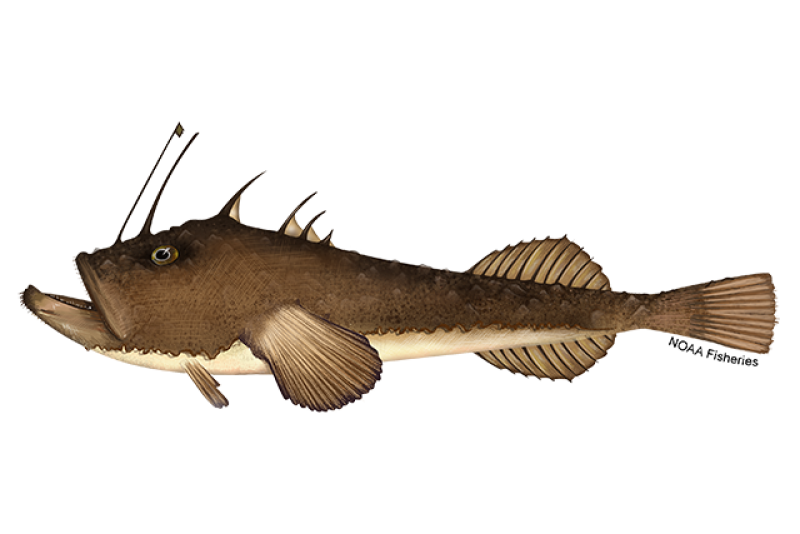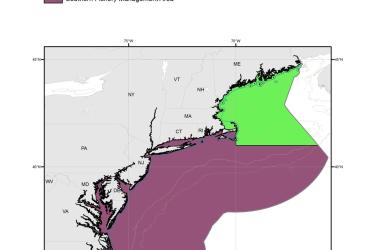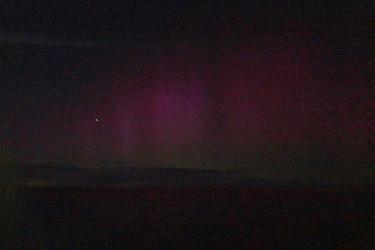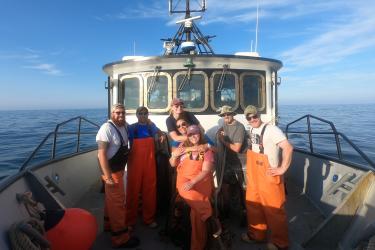Monkfish
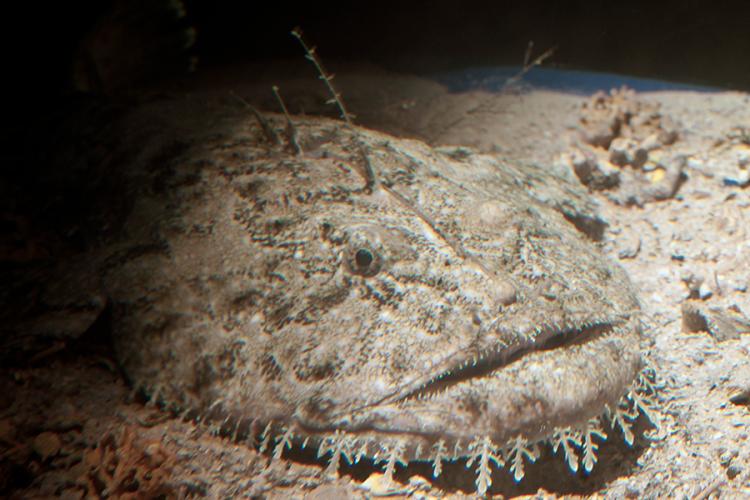 Monkfish. Credit: iStock
Monkfish. Credit: iStock
Monkfish. Credit: iStock
About the Species
 Monkfish. Credit: iStock
Monkfish. Credit: iStock
Monkfish. Credit: iStock
The commercial monkfish fishery in the U.S. operates from Maine to North Carolina out to the continental margin. Trawl gear is primarily used in northern waters, and gillnet gear in southern waters. Because it is common for monkfish to be caught in conjunction with groundfish, you will see a lot of the information on this site also relates to the northeast multispecies (groundfish) fishery. The monkfish fishery is managed using a days-at-sea and trip limit management system. There is no known directed recreational fishery for monkfish. The market for monkfish is for human consumption. U.S. wild-caught monkfish is a smart seafood choice because it is sustainably managed and responsibly harvested under U.S. regulations. Implementing regulations are found at 50 CFR part 648 subpart F.

Population
The population level is unknown and management measures are in place.

Fishing Rate
Overfishing status is unknown, but catch is at recommended level.

Habitat Impact
Area closures and gear restrictions protect habitat affected by some kinds of trawl gear.

Bycatch
Regulations limit possession of bycatch species and require modified fishing gear to reduce bycatch.
Population Status
- There are two stocks of monkfish: Gulf of Maine/Northern Georges Bank and Southern Georges Bank/Mid-Atlantic:
- The Gulf of Maine/Northern Georges Bank stock does not have a stock assessment that provides information about the overfishing and overfished status. A 2022 index-based assessment method is currently used for catch advice, but does not support stock status determinations. This information can be found on Stock SMART.
- The Southern Georges Bank/Mid-Atlantic stock does not have a stock assessment that provides information about the overfishing and overfished status. A 2022 index-based assessment method is currently used for catch advice, but does not support stock status determinations. This information can be found on Stock SMART.
Appearance
- Monkfish have mottled dark brown to olive-green skin on top and whitish skin underneath.
- They are described as tadpole-like in appearance, with a body that is mostly a broad head with a large mouth and a narrow, tapering body.
Biology
- Males and females are able to reproduce when they reach about 14 inches and 16 inches long, respectively.
- Monkfish spawn from February to October.
- Females release large egg veils that can contain more than 1 million eggs.
- These egg veils float near the surface along with the prevailing currents for 1 to 3 weeks (depending on temperature) until the veil disintegrates and the larvae hatch.
- Monkfish migrate seasonally to spawn and feed.
- They travel by slowly swimming or by using the sturdy base of their pectoral fins to walk.
- Scientists speculate that their wing-like pectoral fins may be used to ride currents.
- Monkfish are opportunistic feeders, eating whatever prey is most available at the time.
- Larvae feed on zooplankton (tiny floating animals). Juveniles mostly eat small fish, shrimp, and squid.
- Adults mainly eat fish, including other monkfish, but also feed on crustaceans, mollusks, seabirds, and diving ducks.
- Monkfish ambush their prey—they use a modified spine on their head as a fishing pole and bait to lure small fish toward their mouths.
- When the prey comes near, the monkfish takes a large gulp, which sucks the prey into its mouth and traps it behind rows of back-pointing teeth.
- Large monkfish have few predators.
- Predacious fish such as swordfish, sharks, and thorny skate prey on small monkfish.
Where They Live
Range
- Monkfish are found in the Northwest Atlantic Ocean from the Grand Banks and northern Gulf of St. Lawrence south to Cape Hatteras, North Carolina.
- They can tolerate a wide range of temperatures and depths, from inshore waters down to nearly 3,000 feet.
- Monkfish migrate seasonally to spawn and feed.
Habitat
- Monkfish live on the ocean floor, typically on sand, mud, and shell habitats.
- Adults spend most of their time on the bottom, often in a depression or partially covered in sediment. They also spend some time off the bottom, probably riding currents to help with migration.
Fishery Management
- NOAA Fisheries and the New England and Mid-Atlantic Fishery Management Councils manage the monkfish fishery.
- The New England Fishery Management Council has the lead for developing measures in the monkfish fishery management plan.
- Managed under the Monkfish Fishery Management Plan:
- The monkfish fishery in U.S. waters is divided into two management areas north and south of Georges Bank to accommodate differences in monkfish fishing practices.
- Both areas are managed under the same plan.
- The Northern Fishery Management Area covers the Gulf of Maine and the northern part of Georges Bank. The Southern Fishery Management Area extends from the southern flank of Georges Bank through the Mid-Atlantic Bight to North Carolina.
- Management measures include annual catch limits, limited access permits, size limits, landing limits, and measures to reduce bycatch and impacts on habitat.
Harvest
- Commercial fishery:
- In 2023, commercial landings of monkfish totaled 15.4 million pounds and were valued at $11.8 million, according to the NOAA Fisheries commercial fishing landings database.
- Monkfish is one of the highest valued finfish in the Northeast.
- Almost all of the monkfish for sale in the United States comes from U.S. fisheries.
- Gear types, habitat impacts, and bycatch:
- Fishermen harvest monkfish using bottom trawls, sink gillnets, and scallop dredges.
- Most monkfish caught in the Northern Fishery Management Area are caught by vessels using bottom-trawl gear targeting groundfish.
- Most monkfish caught in the Southern Fishery Management area are caught by vessels using gillnets.
- Although bottom trawls can affect marine habitat, most bottom trawls catch monkfish over sand and mud habitats, which tend to recover from any disturbance more quickly than more structured habitats.
- Managers and researchers believe that monkfish essential fish habitat is only minimally vulnerable to the effects of bottom trawls and sink gillnet gear.
- Managers have implemented a variety of measures to protect habitat of other bottom-dwelling fish from any potential impacts from the monkfish fishery:
- Two areas are closed to monkfish fishing (all gears) year-round to protect sensitive habitat.
- Fishermen must use gear with specific requirements that prevent them from fishing in sensitive hard bottom areas.
- Monkfish fisheries sometimes incidentally catch spiny dogfish and skates, which fishermen are allowed to keep as long as they have the appropriate federal permits and comply with the appropriate regulations for these fisheries.
- There is a limit on the amount of bycatch of other fish species allowed in the monkfish fishery, including possession and landing limits and annual quotas specified in fisheries for those species.
- Mesh on gillnets and trawl nets must be larger than the established minimum size to reduce bycatch.
- Gillnets used to target monkfish can incidentally capture protected species, such as sea turtles, large whales (right, humpback, and fin whales), harbor porpoise, dolphins, and Atlantic sturgeon.
- Monkfish fishermen follow a number of measures to reduce the fishery’s potential impact on protected species:
- In the Mid-Atlantic, management measures prohibit gillnet vessels from using large mesh (7 inches or greater) gillnets in some areas during certain times of the year to protect migrating sea turtles.
- Closures are timed based on projected sea surface temperatures in fishing areas, as sea turtles are known to migrate into these areas when temperatures are about 52 degrees Fahrenheit or higher.
- The closures move large-mesh gillnetting north in advance of sea turtles migrating into fishing areas and, along with other precautions, have greatly reduced incidental catch of sea turtles in the monkfish fishery.
Scientific Classification
- Monkfish are found in the Northwest Atlantic Ocean from the Grand Banks and northern Gulf of St. Lawrence south to Cape Hatteras, North Carolina.
- They can tolerate a wide range of temperatures and depths, from inshore waters down to nearly 3,000 feet.
- Monkfish migrate seasonally to spawn and feed.
- Monkfish live on the ocean floor, typically on sand, mud, and shell habitats.
- Adults spend most of their time on the bottom, often in a depression or partially covered in sediment. They also spend some time off the bottom, probably riding currents to help with migration.
Fishery Management
- NOAA Fisheries and the New England and Mid-Atlantic Fishery Management Councils manage the monkfish fishery.
- The New England Fishery Management Council has the lead for developing measures in the monkfish fishery management plan.
- Managed under the Monkfish Fishery Management Plan:
- The monkfish fishery in U.S. waters is divided into two management areas north and south of Georges Bank to accommodate differences in monkfish fishing practices.
- Both areas are managed under the same plan.
- The Northern Fishery Management Area covers the Gulf of Maine and the northern part of Georges Bank. The Southern Fishery Management Area extends from the southern flank of Georges Bank through the Mid-Atlantic Bight to North Carolina.
- Management measures include annual catch limits, limited access permits, size limits, landing limits, and measures to reduce bycatch and impacts on habitat.
Harvest
- Commercial fishery:
- In 2023, commercial landings of monkfish totaled 15.4 million pounds and were valued at $11.8 million, according to the NOAA Fisheries commercial fishing landings database.
- Monkfish is one of the highest valued finfish in the Northeast.
- Almost all of the monkfish for sale in the United States comes from U.S. fisheries.
- Gear types, habitat impacts, and bycatch:
- Fishermen harvest monkfish using bottom trawls, sink gillnets, and scallop dredges.
- Most monkfish caught in the Northern Fishery Management Area are caught by vessels using bottom-trawl gear targeting groundfish.
- Most monkfish caught in the Southern Fishery Management area are caught by vessels using gillnets.
- Although bottom trawls can affect marine habitat, most bottom trawls catch monkfish over sand and mud habitats, which tend to recover from any disturbance more quickly than more structured habitats.
- Managers and researchers believe that monkfish essential fish habitat is only minimally vulnerable to the effects of bottom trawls and sink gillnet gear.
- Managers have implemented a variety of measures to protect habitat of other bottom-dwelling fish from any potential impacts from the monkfish fishery:
- Two areas are closed to monkfish fishing (all gears) year-round to protect sensitive habitat.
- Fishermen must use gear with specific requirements that prevent them from fishing in sensitive hard bottom areas.
- Monkfish fisheries sometimes incidentally catch spiny dogfish and skates, which fishermen are allowed to keep as long as they have the appropriate federal permits and comply with the appropriate regulations for these fisheries.
- There is a limit on the amount of bycatch of other fish species allowed in the monkfish fishery, including possession and landing limits and annual quotas specified in fisheries for those species.
- Mesh on gillnets and trawl nets must be larger than the established minimum size to reduce bycatch.
- Gillnets used to target monkfish can incidentally capture protected species, such as sea turtles, large whales (right, humpback, and fin whales), harbor porpoise, dolphins, and Atlantic sturgeon.
- Monkfish fishermen follow a number of measures to reduce the fishery’s potential impact on protected species:
- In the Mid-Atlantic, management measures prohibit gillnet vessels from using large mesh (7 inches or greater) gillnets in some areas during certain times of the year to protect migrating sea turtles.
- Closures are timed based on projected sea surface temperatures in fishing areas, as sea turtles are known to migrate into these areas when temperatures are about 52 degrees Fahrenheit or higher.
- The closures move large-mesh gillnetting north in advance of sea turtles migrating into fishing areas and, along with other precautions, have greatly reduced incidental catch of sea turtles in the monkfish fishery.
Scientific Classification
| Kingdom | Animalia | Phylum | Chordata | Class | Actinopterygii | Order | Lophiiformes | Family | Lophiidae | Genus | Lophius | Species | americanus |
|---|
Last updated by NOAA Fisheries on 03/24/2025
Featured News
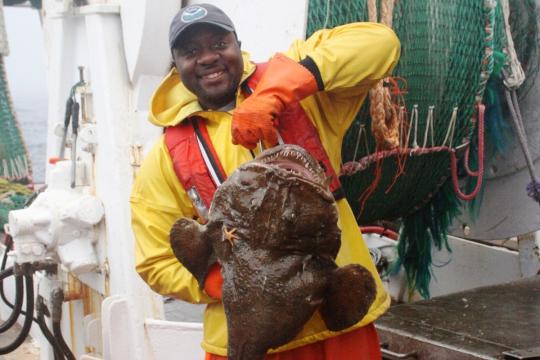 Study Fleet scientist Calvin Alexander holding a monkfish.
Study Fleet scientist Calvin Alexander holding a monkfish.
 Two researchers examining a monkfish. Credit: University of New England
Two researchers examining a monkfish. Credit: University of New England
2023–2024 Monkfish Research Set-Aside Project Recommendations
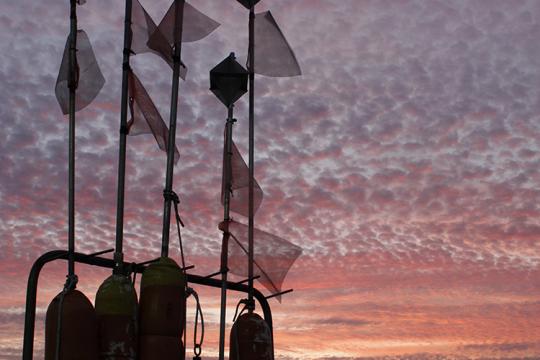 Highflyers, part of the fishing gear, are stored onboard in between fishing efforts. Credit: NOAA Fisheries/Dave McElroy
Highflyers, part of the fishing gear, are stored onboard in between fishing efforts. Credit: NOAA Fisheries/Dave McElroy
Cooperative Research Branch Fall Gulf of Maine Bottom Longline Surveys Completed
 An array of fish and shellfish dishes. Credit: iStock.
An array of fish and shellfish dishes. Credit: iStock.
Recreational Fishing Regulations
There are currently no recreational possession restrictions for monkfish caught in federal waters. Recreational anglers must still comply with minimum fish size regulations in place for the fishery (Currently for monkfish: 17 inches, whole fish; 11 inches, tail only).
Recreational anglers will need to get a general recreational fishing license either through your state or through NOAA Fisheries to fish recreationally for marine species. Visit our permit office or recreational fishing page for more information.
Reporting A Recreational Catch
This is not applicable for the monkfish fishery. Visit the Greater Atlantic Region's recreational fishing page for more information about recreational reporting in general.
Last updated by NOAA Fisheries on 03/24/2025
Commercial Fishing Regulations
Days-At-Sea (DAS)
Each fishing year, limited access monkfish vessels are allocated 35 Monkfish DAS for use in the Northern Fishery Management Area (NFMA) and 37 Monkfish DAS for use in the Southern Fishery Management Area (SFMA). These allocations are reduced by 0.4 DAS in each area; the reduction is put towards the Monkfish Research Set-Aside program. Also, no limited access monkfish vessel may use more than 46 of the annually allocated DAS in a given fishing year.
In addition to the DAS allocated annually, each permit holder may also carry-over up to four unused monkfish DAS from the previous year, which can be applied to either area (Northern Fishery Management Area [NFMA] or SFMA). However, DAS that are not usable because they are tied to a Northeast (NE) multispecies DAS may not be carried over. Carryover DAS do not count towards the annual 46 DAS restriction. For more information on DAS, please see the supplemental info page.
Possession Limits and Fish Size Requirements
Minimum fish size: 17 inches total length (whole fish), or 11 inches tail length (tails only) for both commercial and recreational anglers.
Maximum fish size: None
Possession Limits: Monkfish possession limits vary by permit category, area, gear, and DAS use. The specifics of the catch limits for limited access permit holders and incidental catch limits are outlined in the tables below. When viewing the tables, please be aware of the footnotes that are outlined below.
Possession Limits While on a Monkfish DAS
Northern Fishery Management Area
| Permit Category | A or C | B or D |
|---|---|---|
| Landing Limit1 in tail weight per DAS | 1,250 lb (3,638 lb whole weight) | 600 lb (1,746 lb whole weight) |
Southern Fishery Management Area
| Permit Category | A or C | B, D, or H | F |
|---|---|---|---|
| Landing Limit1 in tail weight per DAS | 700 lb (2,037 lb whole weight) | 575 lb (1,673 lb whole weight) | 1,600 lb (4,656 lb whole weight) |
Possession Limits While on Both a Monkfish DAS and a Northeast Multispecies A DAS
Northern Fishery Management Area
| Permit Category | C or D |
|---|---|
| Landing Limit1 | Unlimited |
Southern Fishery Management Area
| Permit Category | C | D |
|---|---|---|
| Landing Limit1 in tail weight per DAS | 700 lb (2,037 lb whole weight) | 575 lb (1,673 lb whole weight) |
Incidental Possession Limits While on a Northeast Multispecies DAS
| Area | NFMA | SFMA | ||||
|---|---|---|---|---|---|---|
| Permit Category | C | D | E, F, or H | E or H | C, D, or H | |
| Gear | All Gear | Non-Trawl | Trawl | |||
| Landing Limit1 in tail weight per DAS | 900 lb (2,619 lb whole weight) | 750 lb (2,183 lb whole weight) | Up to 25% (converted to tail weight1) of the total weight of fish on board, not to exceed 300 lb | 50 lb (146 lb whole weight) | 300 lb (873 lb whole weight) | |
Note: If you are fishing under a Northeast multispecies DAS, you may have additional possession restrictions based on the specific fishery in which you are participating (e.g., Regular B-DAS Program or the U.S./Canada Management Areas).
Incidental Possession Limits While on a Scallop DAS or in the Sea Scallop Access Area Program
| Sea Scallop Access Area DAS Program2 | Scallop DAS Program | |
|---|---|---|
| Area | NFMA and SFMA | |
| Gear | All Gear | |
| Landing Limit1 in tail weight per DAS | 300 lb (873 lb whole weight) | |
Incidental Possession Limits for Vessels not under a DAS Program
| Program | Area | Gear | Landing Limit1 (in tail weight per trip unless stated otherwise) |
|---|---|---|---|
| No DAS | Gulf of Maine (GOM) or Georges Bank (GB) Regulated Mesh Areas (RMAs) | Minimum mesh size or larger. See "Gear" or "Exempted Fisheries" tabs for more information | Up to 5% (converted to tail weight1) of the total weight of fish on board |
| Southern New England (SNE) RMA east of the Mid-Atlantic (MA) Exemption Area boundary at 72° 30' W longitude | Up to 5% (converted to tail weight1) of the total weight of fish on board, not to exceed 50 lb (146 lb whole weight) per day3, up to 150 lb (437 lb whole weight) per trip | ||
| MA Exemption area west of the MA Exemption Area boundary | Up to 5% (converted to tail weight1) of the total weight of fish on board, not to exceed 450 lb (1,310 lb whole weight) per trip | ||
| NFMA or SFMA | Mesh smaller than the minimum (See tabs mentioned above) | 50 lb (146 lb whole weight) per day3, or partial day, not to exceed 150 lb (437 lb whole weight) per trip | |
| Rod and reel or handlines only | |||
| No DAS and fishing under a skate bait Letter of Authorization | SNE RMA | Minimum mesh size or larger (See tabs mentioned above) | Up to 5% (converted to tail weight1) of the total weight of fish on board, not to exceed 50 lb (146 lb whole weight) per day3, up to 150 lb (437 lb whole weight) per trip |
Incidental Possession Limits for Vessels not under a DAS Program that also Hold Permits in Other Fisheries/Special Cases
| Additional Permit/ Condition | Area | Gear | Landing Limit1 (in tail weight per trip unless stated otherwise) |
|---|---|---|---|
| NE Multispecies Small Vessel Permit4 | NFMA or SFMA | All Gear | 50 lb (146 lb whole weight) per day3, or partial day, not to exceed 150 lb (437 lb whole weight) per trip |
| Surfclam or Ocean Quahog Permit | Hydraulic clam dredge or mahogany quahog dredge | ||
| Sea Scallop Permit | Scallop dredge only (except scallop dredge exemption areas)5 | If in a scallop dredge exemption area, 50 lb (146 lb whole weight) per trip. Otherwise, 50 lb per day3, or partial day, not to exceed 150 lb (437 lb whole weight) per trip |
1 Any prorated combination of tail weight and whole weight may also be landed based on the conversion factor for tail weight to whole weight of 2.91 (tail weight x 2.91 = whole weight; or whole weight/2.91 = tail weight). A vessel may also possess or land monkfish livers up to 25% of the tail weight of monkfish, or up to 10% of the whole weight of monkfish, per trip. If a vessel possesses or lands both monkfish tails and whole monkfish, the vessel may land livers up to 10% of the whole weight of monkfish per trip using the following weight ratio: (0.10) x [(tail weight x 2.91) + (whole fish x 1)]. Vessels may also land monkfish heads separate from tails, provided the total head weight does not exceed 1.91 times the total weight of tails onboard.
2 For vessels with limited access sea scallop permits fishing in an established Sea Scallop Access Area, the monkfish possession limit is per day fished inside the access area (as determined by VMS), not including steaming time.
3 A day is the 24-hour period that begins when the vessel leaves port or, if the vessel has an operational VMS, when the vessel crosses the VMS demarcation line when leaving port and ends when the vessel returns to port or, if the vessel has an operational VMS, crosses the VMS demarcation line on its return to port.
4 These vessels are exempt from a NE multispecies DAS provided they meet the vessel size requirements applicable to the limited access NE multispecies small vessel permit category (vessels < 30 ft in length).
5 In order to possess monkfish in the scallop dredge exemption areas, small dredges must be used (combined width not to exceed 10.5 ft).
Reporting A Commercial Catch
Vessel Trip Reports
Owners/operators of vessels holding a federal monkfish permit must submit vessel trip reports electronically using approved electronic vessel trip report software. eVTRs must be complete to the extent possible prior to entering port and submitted within 48 hours of offloading fish. For more information about trip reporting, and to see a list of approved electronic vessel trip report software applications, please visit the Greater Atlantic Region vessel trip reporting page.
Vessel Monitoring System Requirements
A vessel that meets any of the following criteria must use their Vessel Monitoring System (VMS) unit to declare a monkfish trip:
- Vessel has a Monkfish Category C or D permit if in a sector, or will fish under a northeast multispecies DAS during the year;
- Category F permit (can turn off VMS outside of the offshore fishery season);
- Vessel has another permit that requires the use of a VMS unit; and/or
- Vessel has a Northeast multispecies or scallop permit and are fishing for monkfish outside of an exemption area or under a monkfish DAS.
Please note that vessels with an operational VMS unit that are declaring a trip that either completely shoreward of the VMS demarcation line or both shoreward and seaward of the demarcation line may also declare using the Interactive Voice Response (IVR) system. For trips declared using the IVR system, the vessel owner or operator must call into the IVR system again at the end of the trip.
Interactive Voice Response System Requirements
A vessel that is not required to use a VMS unit, or has an operational VMS unit and will be fishing both inside and outside of the demarcation line on the same trip, must declare through the IVR system accessible via FishOnline prior to leaving port. For trips declared using the IVR system, the vessel owner or operator must call into the IVR system again at the end of the trip.
DAS Adjustment for Trip Limit Overage Provision
A limited access monkfish vessel may land up to one additional day's trip limit worth of monkfish than would otherwise be allowed based on the vessel's actual monkfish DAS usage for that trip. The vessel must declare the extra fish via VMS prior to crossing the demarcation line upon returning to port, or via the IVR line 1 hour prior to landing, to land the additional day's worth of monkfish. To account for the trip limit overage, the monkfish DAS charge will be rounded to the next 24-hr period plus 1 minute.
Example: If you have two days' (trip limits') worth of monkfish on board and you have declared into the monkfish DAS program for 15 hours, once you declare or call in this overage provision, you would be permitted to land 2 days' worth of monkfish. Your DAS charge for the trip would be adjusted from 15 hours to 24 hours and 1 minute. Also, after using the DAS adjustment provision, you may go right back out to start a new trip, even if the additional time has not passed for which your previous trip was charged.
Monkfish Option
To have the flexibility to land monkfish caught in excess of the incidental limit when fishing on a Northeast multispecies A DAS, a vessel must first declare the monkfish option on the vessel's VMS unit before leaving port, and can only fish in the Northern Fishery Management Area (NFMA). If this has been done, the vessel can change the trip declaration from a Northeast multispecies A DAS to a Monkfish DAS declaration before crossing the demarcation line on its return to port. When this is initiated, both Northeast multispecies A DAS and Monkfish DAS are charged in conjunction for the course of the trip, although the VMS declaration will show Monkfish DAS. For assistance with your VMS codes, call our Office of Law Enforcement VMS team at (978) 281-9149.
Requirement for Vessels Fishing Exclusively in the NFMA without a VMS Unit
Because the regulations for the Southern Fishery Management Area (SFMA) are more restrictive (lower possession limits) than the NFMA, a federally permitted monkfish vessel fishing exclusively in the NFMA without an operational vessel monitoring system (VMS) on board must obtain a monkfish letter of authorization (LOA) from NOAA Fisheries. This LOA is issued for a minimum of 7 days and may be obtained by calling our Permit Office at (978) 282-8438. The non-VMS vessel must also make the proper trip declaration through the IVR call-in system. If a vessel has not obtained the LOA and makes a trip declaration through the IVR, it is presumed to have fished in the SFMA, and will be held to the more restrictive requirements of the SFMA.
This does not apply to vessels with an operational VMS unit. Instead of obtaining the LOA and declaring the trip through IVR, vessels with VMS on board must instead declare the area to be fished using VMS.
Requirement for Vessels Fishing Exclusively in the NFMA and Transiting Through the SFMA
A vessel that has declared into the NFMA (LOA and IVR, or through VMS), may transit the SFMA, provided the vessel does not harvest or possess monkfish or any other fish from the SFMA, and all fishing gear is properly stowed and not available for immediate use.
Observer Requirements
The monkfish fishery does not have specific observer requirements, but must abide by Northeast multispecies and/or scallop regulations if fishing on a DAS for one of those fisheries. Also, all sector vessels fishing on a monkfish DAS are required to participate in the at-sea monitoring program, because all catch of allocated groundfish stocks on that trip (including discards) counts against sector ACE. Additionally, all federally permitted vessels are obligated to carry an observer if randomly selected by the National Observer Program.
Commercial Gear Information
Gear Requirements
The monkfish fishery has some gear requirements that vary based on permit category, other types of permits owned, and planned fishing activity. All of the following gear requirements apply while fishing for monkfish under a Monkfish day-at-sea (DAS) unless otherwise noted.
Dredge
Dredge gear is prohibited on a Monkfish DAS. You may not have a dredge onboard your vessel while fishing on a Monkfish DAS trip.
Trawl
The minimum mesh size is 10-inch square or 12-inch diamond mesh throughout the codend for at least 45 continuous meshes forward of the terminus of the net. The minimum mesh size for the remainder of the trawl net is the regulated mesh size specified by the regulated mesh area being fished, as outlined in the Northeast multispecies regulations.
Exception: If you have a Monkfish Category C, D, or H permit and are fishing with trawl gear under both a monkfish and Northeast multispecies DAS, you are subject to the minimum mesh size determined by the Northeast multispecies fishery.
The maximum roller size in the Southern Fishery Management Area (SFMA) is 6 inches in diameter.
Gillnet*
The minimum mesh size is 10-inch diamond mesh. On May 1, 2026, the minimum mesh size for gillnet gear will be 12-inch diamond mesh.
Exception 1: If you have a Category C, D, or H permit and a Northeast multispecies permit, fishing in the Northern Fishery Management Area (NFMA), and switch from a Northeast multispecies VMS declaration to a monkfish VMS declaration by using the "monkfish option" on your VMS unit, you may continue to use gillnet gear with less than 10-inch diamond mesh. However, you must go by the more restrictive mesh sizes as outlined in the Northeast multispecies regulations.
Exception 2: If you have a Category C, D, or H permit and a Northeast multispecies permit, and you are fishing in the SFMA on a monkfish DAS and a Northeast multispecies DAS, you may fish with standup gillnets as small as 6.5 inches.
If you have a Category A or B permit, you may not fish with, haul, possess, or set more than 160 gillnets at any time.
If you have a Category C, D, F, or H permit and a limited access Northeast multispecies permit, you may not fish with, haul, possess, or set more than 150 gillnets at any time. Note: If you are also fishing on a Northeast multispecies DAS, you must go by the more restrictive net limits of the Northeast multispecies regulated mesh areas (§ 648.80).
All gillnets must be tagged with one tag per net, and cannot be longer than 300 ft.
New Jersey Atlantic Sturgeon Bycatch Reduction Area
Starting January 1, 2026, vessels fishing on a Monkfish DAS within the New Jersey Atlantic Sturgeon Bycatch Reduction Area using gillnet gear with mesh 10 inches or greater must use low-profile gillnets, year round.
For more information, including maps of these areas, follow the link above or in the More Information box on this page.
*Gillnet and trap/pot fisheries also have Protected Resources requirements to protect marine mammals and other protected species. Please contact the Protected Resources Division at (978) 281-9328 for more information, or visit their web page.
Last updated by NOAA Fisheries on 03/24/2025
Seafood Facts

Is Monkfish Sustainable?
U.S. wild-caught monkfish is a smart seafood choice because it is sustainably managed and responsibly harvested under U.S. regulations.
Availability
Year-round, with peaks in the late fall and spring.
Source
U.S. wild-caught from Maine to North Carolina.
Taste
Mild.
Texture
The tail meat is firm, dense, and relatively boneless. The meat is not flaky and has a texture similar to lobster meat. Raw monkfish is covered with a blue-gray membrane, which should be removed before cooking. If left on, the membrane will shrink, and the meat will curl and become tough.
Health Benefits
Low in sodium; a good source of niacin, vitamins B6 and B12, and potassium; and a very good source of protein, phosphorus, and selenium.
Nutrition Facts
Servings: 1; Serving Weight: 100 g (raw); Calories: 76; Protein: 14.48 g; Total Fat: 1.52 g; Total Saturated Fatty Acids: 0.34 g; Carbohydrate: 0 g; Total Sugars: 0 g; Total Dietary Fiber: 0 g; Cholesterol: 25 mg; Selenium: 36.5 mcg; Sodium: 18 mgMonkfish Recipes
Monkfish is an often overlooked seafood species with meat similar to lobster. If you need cooking inspiration, browse these recipes for monkfish karaage, monkfish bisque, and more!

Last updated by NOAA Fisheries on 03/24/2025
Seafood News
 Fresh-caught taʻape on ice. Credit: Conservation International Hawaiʻi.
Fresh-caught taʻape on ice. Credit: Conservation International Hawaiʻi.
Reducing Waste and Feeding Communities in Hawaiʻi with a Whole Fish Approach
 Chef Tyler Hadfield’s Curried Skate Wings with Tomato-Masala Chutney
Chef Tyler Hadfield’s Curried Skate Wings with Tomato-Masala Chutney
Ring In the New Year With These Crowd-Favorite Seafood Recipes
 NOAA Fisheries, in collaboration with Blue Ocean Mariculture, is conducting a multi-year pilot study to evaluate observational methods and tools for studying Hawaiian monk seal behavior. Courtesy of Blue Ocean Mariculture
NOAA Fisheries, in collaboration with Blue Ocean Mariculture, is conducting a multi-year pilot study to evaluate observational methods and tools for studying Hawaiian monk seal behavior. Courtesy of Blue Ocean Mariculture
AI Meets Aquaculture to Study Hawaiian Monk Seal Interactions With Net Pens
 Tonya Wick aboard a fishing vessel at sea in 1998. Photo courtesy of Tonya Wick
Tonya Wick aboard a fishing vessel at sea in 1998. Photo courtesy of Tonya Wick
Exempted Fishing
What is an Exempted Fishery?
Exempted fisheries allow vessels to fish for specific species without being subject to certain Northeast multispecies regulations, including days-at-sea, provided the bycatch of regulated species is minimal. To be approved and implemented, exemption programs must have demonstrated that incidental catch of Northeast multispecies is less than five percent of the total catch, by weight, and that the exemption will not jeopardize fishing mortality objectives.
Monkfish Fishery Exemptions
To fish a monkfish day-at-sea (DAS) as monkfish-only DAS (not also using scallop or Northeast multispecies DAS), you must fish exclusively in an exemption area or exempted fishery. If you choose to fish outside of the exemption area or an exempted fishery, you are also required to use a Northeast multispecies or scallop DAS simultaneously with your monkfish DAS.
Monkfish Exemption Areas
There are five main exemption areas that apply to the monkfish fishery. Visit the provided summary pages for more detailed information about each one.
- Gulf of Maine (GOM)/Georges Bank (GB) Monkfish Gillnet Exemption
- Southern New England (SNE) Monkfish Trawl Exemption Area
- SNE Monkfish Gillnet Exemption Area
- Mid-Atlantic (MA) Exemption Area
- MA Monkfish Exempted Gillnet Fishery
Possession Limits and Mesh Sizes Associated with the SNE and MA Exemption Areas
If you are using trawl gear, you need to be aware that your monkfish incidental trip limits depend upon whether you are fishing on either the east side or the west side of the boundary between the SNE and MA exemption areas. The chart below depicts this area and the table at the end of this section shows the different incidental trip limits.
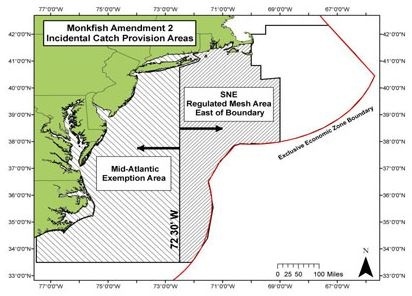
Minimum mesh size is defined by the summer flounder regulations when fishing west of the SNE/MA Exemption Area boundary, but is defined by the Northeast multispecies regulations when fishing east of this boundary in the SNE Regulated Mesh Area and Exemption Areas. For a specific breakdown of areas, gear, and trip limits, refer to the table below.
Southern Exemption Area Trip Limits by Mesh Size
| Side of SNE/MA Exemption Area Boundary | West | East | ||
|---|---|---|---|---|
| Smallest Mesh Fished During Trip | 5.5-inch diamond/6-inch square, or larger, in body, extensions, and codend | Smaller than 5.5-inch diamond/6-inch square in body, extensions, and codend | Smaller than 6-inch diamond/ 6.5-inch square in body and extensions; and 6.5-inch square or diamond in the codend | 6-inch diamond/ 6.5 inch square, or larger, in body and extensions; and 6.5-inch square or diamond, or larger, in the codend |
| Landing Limit1 (per trip unless stated otherwise) | 5% of total weight of fish aboard, up to 450 lb per trip | 50 lb per day2, up to 150 lb per trip | 5% of total weight of fish aboard, not to exceed 50 lb per day2, up to 150 lb per trip | |
1Any prorated combination of tail weight and whole weight may also be landed based on the conversion factor for tail weight to whole weight of 2.91 (tail weight x 2.91 = whole weight; or whole weight/2.91 = tail weight). A vessel may also possess or land monkfish livers up to 25% of the tail weight of monkfish, or up to 10% of the whole weight of monkfish, per trip. If a vessel possesses or lands both monkfish tails and whole monkfish, the vessel may land livers up to 10% of the whole weight of monkfish per trip using the following weight ratio: (0.10) x [(tail weight x 2.91) + (whole fish x 1)]. Vessels may also land monkfish heads separate from tails, provided the total head weight does not exceed 1.91 times the total weight of tails onboard.
2A day is the 24-hour period that begins when the vessel leaves port or, if the vessel has an operational VMS, when the vessel crosses the VMS demarcation line when leaving port and ends when the vessel returns to port or, if the vessel has an operational VMS, crosses the VMS demarcation line on its return to port.
A vessel's monkfish incidental catch limit is based upon the mesh size of the smallest mesh fished during the trip. For example, if you are fishing for squid using a 1-7/8-inch diamond mesh and for summer flounder using a 5.5-inch diamond mesh on the same trip west of the 72° 30" W boundary line, you are subject to the more restrictive possession limit of 50 lb tail weight per day, up to 150 lb tail weight per trip.
Northwest Atlantic Fisheries Organization (NAFO) Regulatory Area Exemption Program
A vessel issued a valid High Seas Fishing Compliance Permit and that complies with the associated requirements is exempt from monkfish permit, mesh size, effort-control, and possession limit restrictions while transiting the EEZ with monkfish on board the vessel, or landing monkfish in U.S. ports that were caught while fishing in the NAFO Regulatory Area. A letter of authorization is required for participation in the NAFO Exemption Program, and other requirements and restrictions may apply. For more information, visit the NAFO website.
Last updated by NOAA Fisheries on 03/24/2025
Management Overview
The monkfish fishery is jointly managed by the New England and Mid-Atlantic Fishery Management Councils. NOAA Fisheries is the implementing body for rules and regulations within the fishery. The fishery is managed under a days-at-sea (DAS are the number of days that can be fished per year) management system with corresponding trip limits per DAS.
The range for the monkfish fishery is the EEZ north of the North Carolina/South Carolina border (Maine through North Carolina). However, there are two separate management areas within that range based on different fishing activity/operations between the two areas: the Northern Fishery Management Area (NFMA) and the Southern Fishery Management Area (SFMA). The boundary between the NFMA and the SFMA runs south along the 70° W longitude line from the south-facing shoreline of Cape Cod, MA, to 41° N latitude, then eastward to the U.S.-Canada maritime boundary. There are also two closed areas in the Monkfish FMP. For more information on these areas, visit our Monkfish Fishery Closed Areas page.

Different Requirements in the NMFA
Because the regulations for the SFMA are more restrictive (lower possession limits) than the NFMA, a federally-permitted monkfish vessel fishing exclusively in the NFMA without an operational vessel monitoring system (VMS) on board must obtain a monkfish Letter of Authorization (LOA) from NOAA Fisheries. This LOA is issued for a minimum of 7 days and may be obtained by calling our Permit Office at (978) 282-8438. The non-VMS vessel must also make the proper trip declaration through the interactive voice response (IVR) system in FishOnline. If a vessel has not obtained the LOA and makes a trip declaration through the IVR, it is presumed to have fished in the SFMA, and will be held to the more restrictive requirements of the SFMA.
This does not apply to vessels with an operational VMS unit. Such vessels must declare the area to be fished using VMS.
Requirement for NFMA Vessels Transiting Through the SFMA
A vessel that has declared into the NFMA (LOA and IVR, or through VMS), may transit the SFMA, provided that it does not harvest or possess monkfish or any other fish from the SFMA. All fishing gear must also be properly stowed and not available for immediate use.
Management Plans
2024 Monkfish Specifications (May 1, 2024 to April 30, 2025)
| Stock | Northern Monkfish | Southern Monkfish |
|---|---|---|
| Overfishing Limit (OFL) | Unknown | Unknown |
| Acceptable Biological Catch (ABC) | 6,224 mt | 5,861 mt |
| Annual Catch Limit (ACL) | 6,224 mt | 5,861 mt |
| Annual Catch Target (ACT) | 6,038 mt | 5,685 mt |
| Total Allowable Landings (TAL) | 5,309 mt | 3,481 mt |
Research Set-Aside: 500 Days at Sea (DAS) per year.
How often do the quotas change for this fishery? Quotas, catch limits, and other fishery management measures are reviewed annually and may be adjusted for each stock for multiple years as necessary.
What if specifications are not in place at the start of the fishing year? If the effective date of a final rule to implement an annual framework adjustment falls after the start of the year, fishing may continue under the existing regulations, but any DAS used by a vessel on or after the start of a fishing year shall be counted against any DAS allocation the vessel ultimately receives for that fishing year.
Are there in-season adjustments (changes mid-fishing year) in this fishery? Adjustments to management measures may be made by the Councils or the Regional Administrator or the Joint Monkfish Oversight Committee with the approval of the Council at any time (including in-season), if it is determined that action is necessary to meet or be consistent with the goals and objectives of the Monkfish Fishery Management Plan. However, these situations would require public comment and at least one Council meeting to take action.
Accountability Measures: The ACTs established for each management area are the basis for setting management measures (DAS and trip limits) in those areas after accounting for incidental catch in non-directed fisheries and discards.
In the event that an ACL is exceeded in a given fishing year, the exact amount in pounds by which the ACL was exceeded shall be deducted from the ACT for the corresponding monkfish stock on a pound-for-pound basis. The revised ACT and corresponding management measures (DAS and trip limits) will be implemented through a framework adjustment process in the second fishing year following the fishing year in which the ACL overage occurred.
Regulatory History
- Mid-1980s – Directed trawl and gillnet fisheries for monkfish grow rapidly.
- 1989 – European and Mediterranean monkfish species overfished, spurring greater demand for U.S. monkfish.
- Early 1990s – Fishing industry expresses concerns over dramatically increased fishing mortality rates, gear conflicts, growing directed trawl fishery, and a decline in size of landed monkfish.
- 1997 – Landings peaked at 62 million pounds (28,123 metric tons), with revenues of $35 million.
- 1997 – Atlantic Large Whale Take Reduction Plan was developed to reduce the likelihood of fishing gear entanglements of right, humpback, fin, and minke whales in the North Atlantic.
- 1998 – Harbor Porpoise Take Reduction Plan became effective and required gear modifications and area closures to reduce the likelihood of fishing gear entanglements of harbor porpoise.
- 1999 – Monkfish FMP was implemented which included a limited access permit program, a DAS management system, trip limits, and minimum size limits.
- 1999 – Amendment 1 approved to ensure compliance with essential fish habitat requirements of the Magnuson-Stevens Act.
- 2002 – Framework Adjustment 1 was disapproved by NOAA Fisheries. NOAA Fisheries instead published an emergency rule that implemented measures based upon the best available science to temporarily suspend the restrictive Year 4 default management measures that would have become effective May 1, 2002.
- 2003 – Framework Adjustment 2 modified the overfishing definition and implemented annual adjustments to the management measures.
- 2003 – Sea Turtle Conservation Final rule implemented a series of seasonal closures that prohibited the use of large mesh gillnets in Federal waters off the coast of Virginia and North Carolina to reduce the impact of the monkfish fishery on endangered and threatened species of sea turtles.
- 2005 – Amendment 2 addressed essential fish habitat, bycatch concerns, and issues raised by public comments.
- 2006 – Framework Adjustment 3 implemented to prohibit targeting monkfish on Multispecies B-regular DAS.
- 2007 – Interim management measures Framework 4 adopted in May to address overfishing while NOAA Fisheries conducted a stock assessment. Framework 4 was implemented in October to establish 3-year target total allowable catches (TACs), a target TAC backstop provision, and adjustments to DAS allocations and trip limits.
- 2007 – Amendment 3 was implemented as an Omnibus Amendment to standardize bycatch reporting methodology for monkfish and other fisheries.
- 2008 – NOAA Fisheries implemented Framework 5 to ensure the Monkfish Fishery Management Plan succeeds in keeping landings within the target total allowable catch levels. Measures include reduction in carryover DAS, reduction in bycatch or incidental catch limits, and revision in the biological reference points used to determine if the stock is overfished.
- 2008 – Framework 6 eliminated the backstop provision adopted in Framework Adjustment 4 to the FMP, October 2007.
- 2011 – Amendment 5 implemented a suite of measures including annual catch limits and accountability measures, measures to promote efficiency and reduce waste, and bring the biological reference points into compliance.
- 2011 – Framework Adjustment 7 implemented measures that were disapproved in Amendment 5 due to newly available science. Specifically, DAS allocations, trip limits, and an annual catch target for the Northern Area.
- 2013 – NOAA Fisheries implements an emergency action to suspend the monkfish possession limits in the Northern Fishery Management Area for monkfish permit categories C and D under a monkfish DAS.
- 2014 – Framework Adjustment 8 implemented measures to incorporate results of latest stock assessment, increase monkfish day-at-sea allocations and landing limits to better achieve optimum yield, and increase operational flexibility by allowing all limited access monkfish vessels to use an allocated monkfish-only day-at-sea at any time throughout the fishing year and Category H vessels to fish throughout the Southern Fishery Management Area.
- 2015 – Amendment 4 implemented Standardized Bycatch Reporting Methodology.
- 2016 – Framework Adjustment 9 eliminated the monkfish possession limit in the NFMA for Category C and D vessels fishing on both a Monkfish and NE Multispecies DAS, and revised the minimum mesh size and possession restrictions in the SFMA.
- 2017 – Framework Adjustment 10 implemented monkfish specifications for fishing years 2017–2019, and increased days-at-sea allocations and trip limits.
- 2020 – Framework Adjustment 12 implemented monkfish specifications for fishing years 2020–2022, and clarified the requirement for IVR vessels to call into a trip no more than an hour in advance of leaving port and the monkfish whole weight incidental possession limits in the Northeast multispecies exempted fisheries.
- 2023 – Framework Adjustment 13 implemented specifications for fishing years 2023–2025, adjusted DAS allocations, and a future change in the minimum mesh size for gillnet gear.
- 2024 – Framework Adjustment 15 implemented measures to reduce bycatch of Atlantic sturgeon in the monkfish and spiny dogfish large-mesh gillnet fisheries.
Last updated by NOAA Fisheries on 03/24/2025
Science Overview
NOAA Fisheries conducts various research activities on the biology, behavior, and population health of monkfish. The results of this research are used to inform management decisions for this species.
For detailed information about stock status, management, assessments, and resource trends, you can search for monkfish, and any other species of interest, using NOAA’s StockSMART web tool.
Monkfish Research in the Northeast
NOAA’s Monkfish Research Set-Aside Program allocates 500 days-at-sea from the directed monkfish fisheries for monkfish-related research projects, including groups, maturity, and migration studies. Researchers are also working with commercial fishermen to put electronic tags on hundreds of monkfish in the waters of southern New England and the Gulf of Maine. These electronic tags help track where monkfish go during their lifetime, and answer other questions about their biology.
NOAA’s Northeast Fisheries Science Center runs the Cooperative Monkfish Research Program in collaboration with members of the monkfish industry. The program supports cooperative surveys to estimate monkfish population status, stock assessment workshops, and the Monkfish Egg Veil Sighting Network, which helps scientists better understand when and where monkfish spawn and where the egg veils travel.
Last updated by NOAA Fisheries on 03/24/2025
Data & Maps
Research
Frequently Asked Questions: Research Set-Aside Program
Detailed information about the Northeast's research funding program.
Last updated by NOAA Fisheries on 03/24/2025
